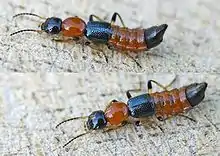Nairobi fly
Nairobi fly is the common name for two species of rove beetle in the genus Paederus, native to East Africa.[1] The beetles contain a corrosive substance known as pederin, which can cause chemical burns if it comes into contact with skin.[2][3] Because of these burns, the Nairobi fly is sometimes referred to as a "dragon bug."
| Nairobi fly | |
|---|---|
 | |
| Scientific classification | |
| Kingdom: | |
| Phylum: | |
| Class: | |
| Order: | |
| Family: | |
| Genus: | |
| Species: | P. eximius and P. sabaeus |
| Binomial name | |
| Paederus eximius | |
| Paederus sabaeus | |
Description
Adult beetles are predominantly black and red in colour, and measure 6–10 mm in length and 0.5–1.0 mm in width.[4] Their head, lower abdomen, and elytra are black, with the thorax and upper abdomen red.[5]
Biology
The beetles live in moist habitats and are often beneficial to agriculture because they will eat crop pests. Adults are attracted to incandescent and fluorescent lights, and as a result, inadvertently come into contact with humans.[5]
Heavy rains, sometimes brought on by El Niño events, provide the conditions for the Nairobi fly to thrive. Outbreaks have occurred in 1998,[3] 2007, 2019, 2020.
Relationship to humans
Paederus dermatitis
The beetles neither sting nor bite, but their haemolymph contains pederin, a potent toxin that causes blistering and Paederus dermatitis. The toxin is released when the beetle is crushed against the skin, often at night, when sleepers inadvertently brush the insect from their faces. People are advised to gently brush or blow the insect off their skin to prevent irritation.[3][5]
References
- Pokhrel, Amrit; Bastakoti, Sanjiv (2022-09-01). "Nairobi fly in South Asia: A catastrophic threat of the nature". Annals of Medicine and Surgery. 81: 104358. doi:10.1016/j.amsu.2022.104358. ISSN 2049-0801. PMC 9486622. PMID 36147184.
- Qadir, Syed Nurul Rasool; Raza, Naeem; Rahman, Simeen Ber (2006). "Paederus dermatitis In Sierra Leone". Dermatology Online Journal. 12 (7): 9. doi:10.5070/D38b58k49j. PMID 17459295.
- "'Nairobi fly' doesn't sting or bite, but it sure does hurt". CNN. January 26, 1998. Archived from the original on January 28, 2007.
- Stefano Veraldi & Luciano Süss (1994). "Dermatitis caused by Paederus fuscipes Curt". International Journal of Dermatology. 33 (4): 277–278. doi:10.1111/j.1365-4362.1994.tb01045.x. PMID 8021088. S2CID 28819765.
- Mammino, Jere J. (November 2011). "Paederus Dermatitis". The Journal of Clinical and Aesthetic Dermatology. 4 (11): 44–46. ISSN 1941-2789. PMC 3225135. PMID 22125660.